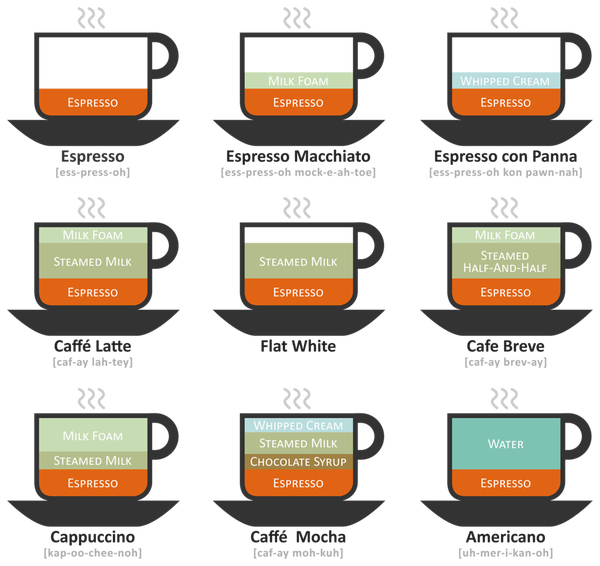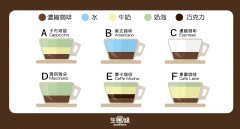[understanding of a picture] Coffee types and prices of common coffee in coffee shops

Professional coffee knowledge exchange more coffee bean information please follow the coffee workshop (Wechat official account cafe_style)
Introduction and nomenclature of various rare coffee varieties
When I was young, I used to work in a coffee shop and saw a living example that I didn't know the kind of coffee.
It is said that on a sunny afternoon, a beautiful girl from a high school student ordered a cup of cappuccino very handsomely. As a first-class service, I immediately brought coffee and delivered it. So carelessly watched her take the first sip, suddenly the beautiful girl had a bitter look on her face, and then watched him silently open three packets of sugar and add it to the coffee, stirring as if nothing had happened.
Now think about it, if only there was a coffee picture!
In order to make it easier for everyone to order coffee, here is a picture of the type of coffee that you can understand at a glance.
Coffee drinks.pngsoure
Espresso espresso: espresso
People are used to calling Espresso espresso. The country of invention of this espresso is Italy, so we often call espresso espresso or espresso. Espresso is extracted by high temperature and high pressure. Espresso is usually strong and stronger, so it is often used as the basis for fancy coffee.
Espresso Macchiato Macchiato: milk foam + espresso
Macchiato is on espresso with a little bit of milk foam. Because only a little bit of milk foam, you must taste it carefully in order to feel the slight smell of milk.
Espresso con Panna Campbell Blue: whipped cream + espresso
Campbell blue is squeezed with cold whipped cream on an espresso. Campbell Blue is also known as Snow Mountain Coffee because of the snow-white whipped cream.
Caffe Latte latte: milk foam + milk + espresso
In general, in latte coffee, the ratio of coffee to fresh milk and milk foam is 1:2:1. When you see this ratio, you can see that milk is the protagonist of latte coffee. If you compare him with cappuccino, latte coffee will have more fresh milk taste. The proportion of coffee and milk in the latte is also the most suitable for making coffee flowers.
Flat White white coffee: milk + espresso
Basically, the proportion of white coffee is very similar to that of lattes, except that there is no foam in the end.
Cafe Breve: milk foam + half milk and half cream + espresso
The translation of this kind of coffee does not seem to be unified, so let's call it Brevie Coffee. The proportion of Brevie coffee is very similar to that of latte coffee, and only after drinking it can you feel the smooth and creamy taste different from latte coffee.
Cappuccino cappuccino: milk foam + milk + espresso
The difference between cappuccino and latte is mainly in the amount of milk. Cappuccino is 1:1:1 in terms of coffee, fresh milk and milk foam, while the color of cappuccino is usually dark brown in coffee, like a dark brown coat worn by a friar of the order of St. Franciscans in Italy. The name cappuccino comes from the Italian word for Cappuccino, which also means a friar of St. Franciscans. In terms of taste, it is dominated by coffee and supplemented by milk. And full-bodied coffee and dense milk foam is the most fascinating thing about cappuccino.
Caffe Mocha mocha: whipped cream + milk + chocolate + espresso
Mocha coffee is even people who do not like coffee want a taste, chocolate sweet and coffee bitter, so that the coffee bitter up, this sweet with a little bitterness is also the favorite of many beauties.
Americano American Coffee: water + espresso
Usually a cup of American coffee consists of two espresso and 30 to 470ml hot water. Because of the large amount of hot water, the appearance or taste of American coffee is much lighter. This casual and simple American coffee soon became popular as the American chain system infiltrated all over the world.
Many people order coffee, their growth is restricted, and they only order a cup of cappuccino or latte they are used to.
Now that you know the difference in the types of coffee, have you ever thought of putting a picture of coffee at home? So you can try to write a different cup of coffee at home next time. Give you a more variety and more interesting coffee description chart, so that you don't have to worry about what kind of coffee to drink!
Introduction to the sources of common coffee varieties in Daquan Coffee
Important Notice :
前街咖啡 FrontStreet Coffee has moved to new addredd:
FrontStreet Coffee Address: 315,Donghua East Road,GuangZhou
Tel:020 38364473
- Prev

A picture to learn about the common types and characteristics of coffee in cafes with a picture introduction
Professional coffee knowledge exchange more coffee bean information please pay attention to the coffee workshop (Wechat official account cafe_style) a variety of rare coffee introduction and variety naming methods everywhere cafes, but pick up the coffee menu, how to choose a dazzling variety of lattes, cappuccinos, mochas and Maggiados? What kind of coffee do you like? Let's take a look.
- Next

Starbucks 2017 coffee price list Starbucks latest menu price Menu catalog menu price list
Professional coffee knowledge exchange more coffee bean information please follow the coffee workshop (Wechat official account cafe_style) a variety of rare coffee introduction and variety naming methods Starbucks includes the latest Starbucks menu prices, Menu, catalogs, menus, price lists, delivery calls and the latest offers and other information, as well as APP free download! The content of MENU is based on different products
Related
- Beginners will see the "Coffee pull flower" guide!
- What is the difference between ice blog purified milk and ordinary milk coffee?
- Why is the Philippines the largest producer of crops in Liberia?
- For coffee extraction, should the fine powder be retained?
- How does extracted espresso fill pressed powder? How much strength does it take to press the powder?
- How to make jasmine cold extract coffee? Is the jasmine + latte good?
- Will this little toy really make the coffee taste better? How does Lily Drip affect coffee extraction?
- Will the action of slapping the filter cup also affect coffee extraction?
- What's the difference between powder-to-water ratio and powder-to-liquid ratio?
- What is the Ethiopian local species? What does it have to do with Heirloom native species?

